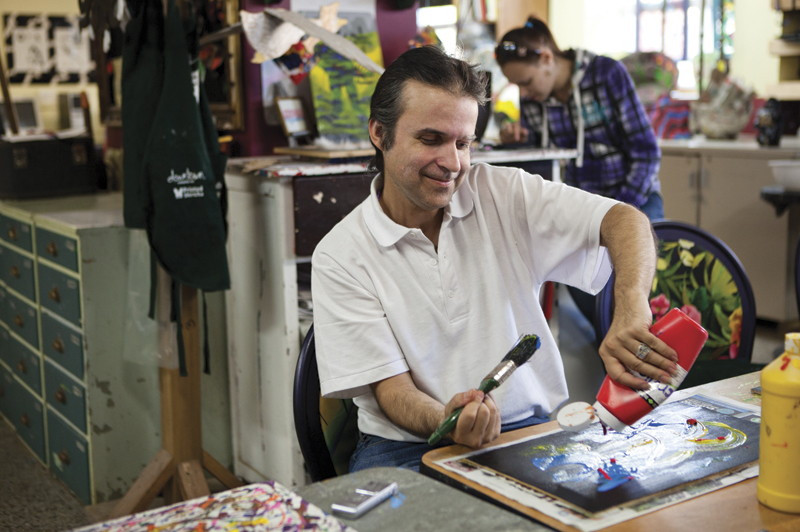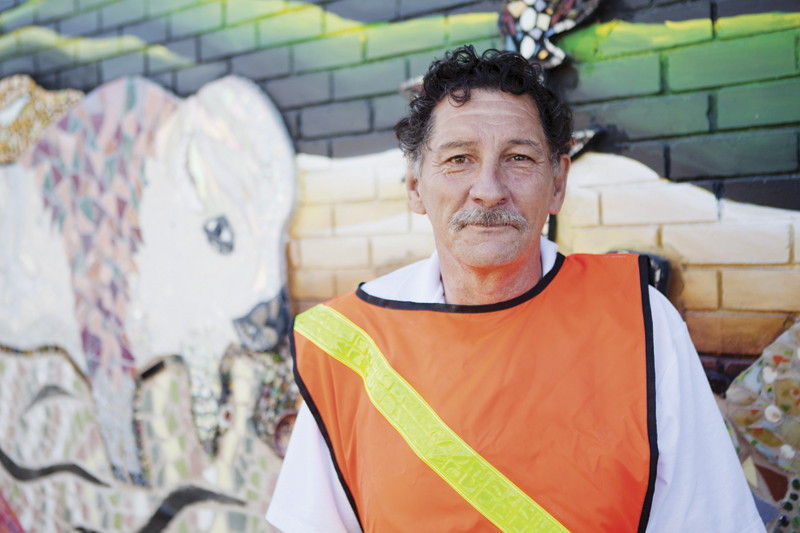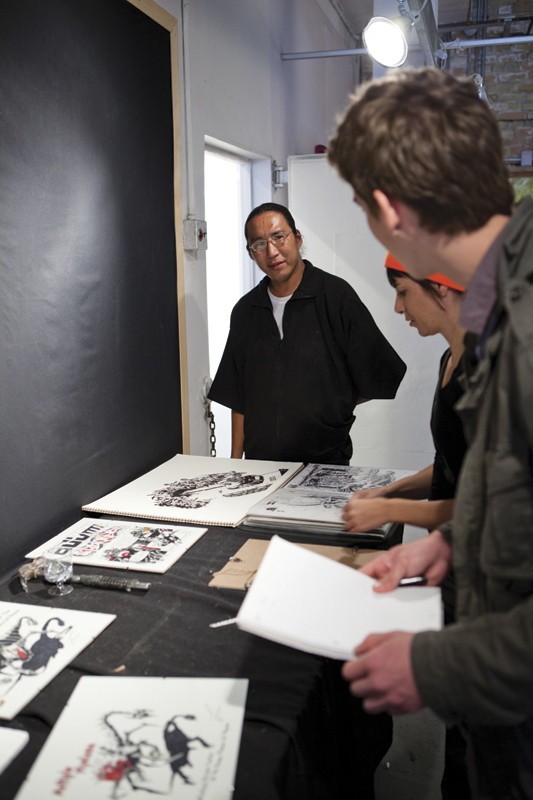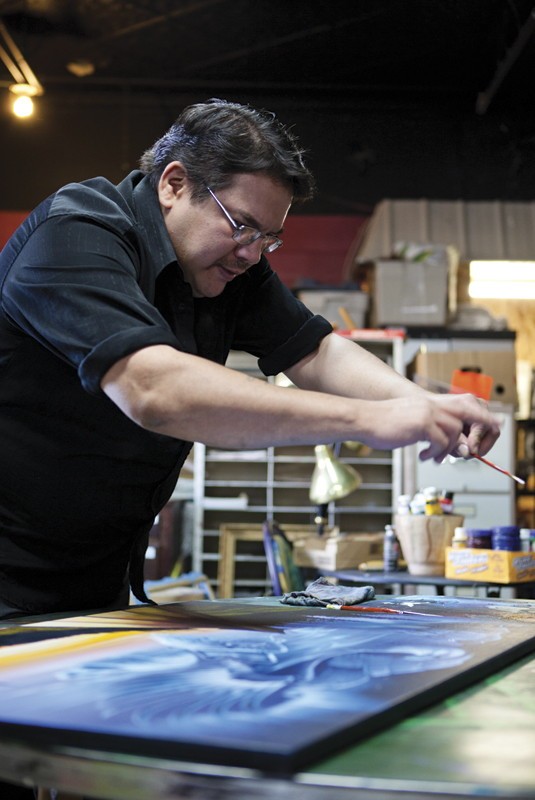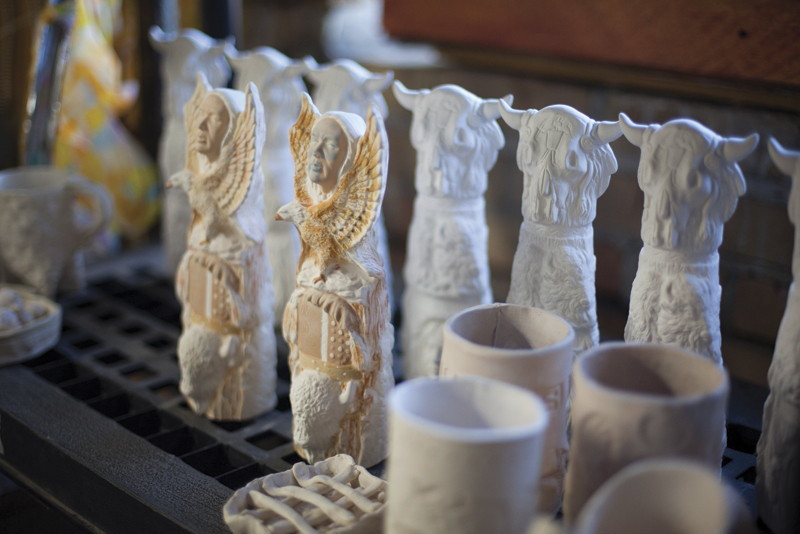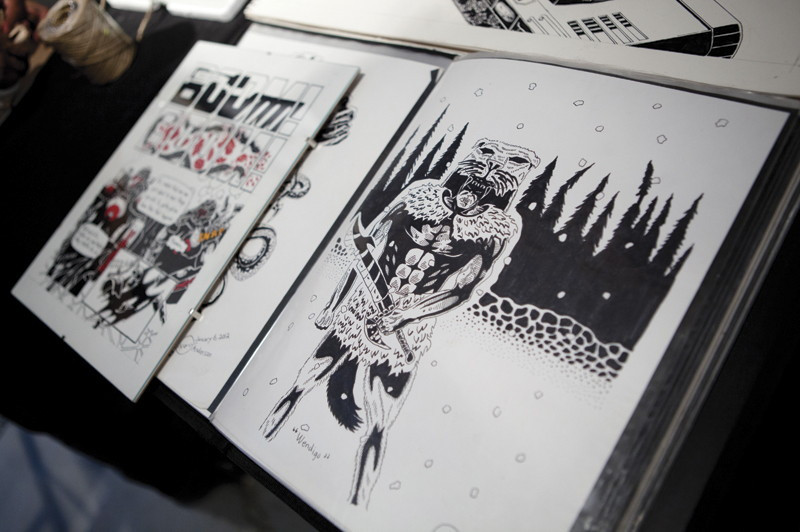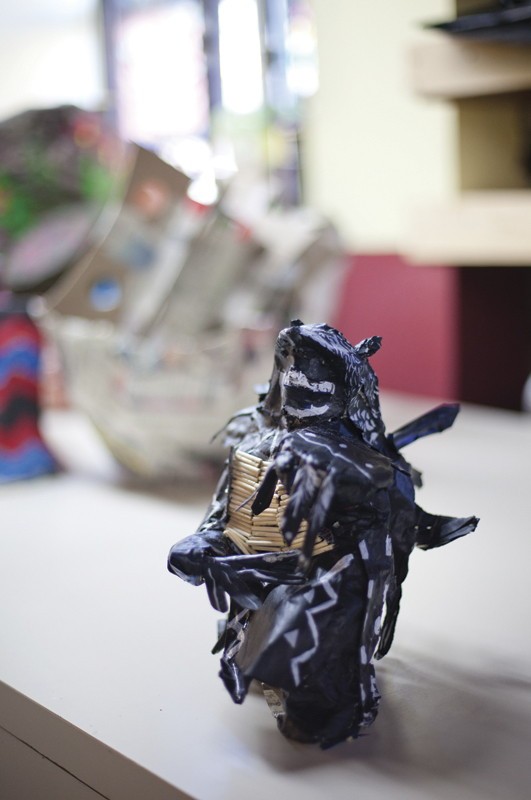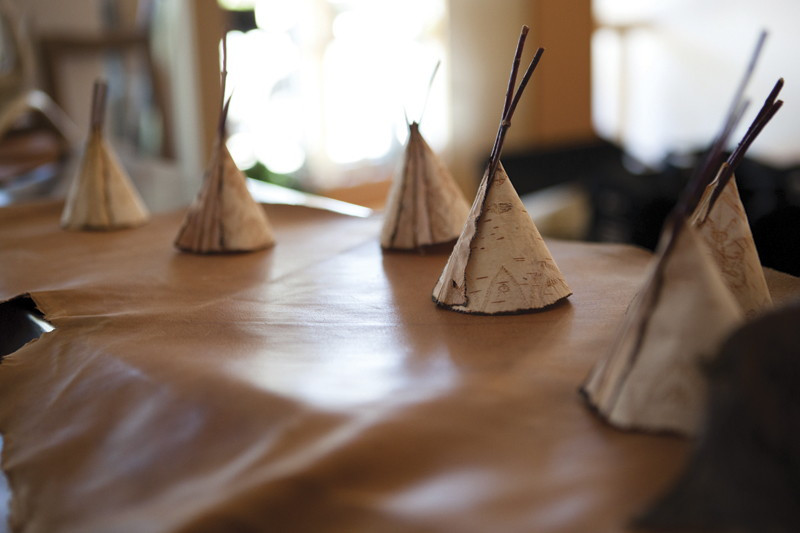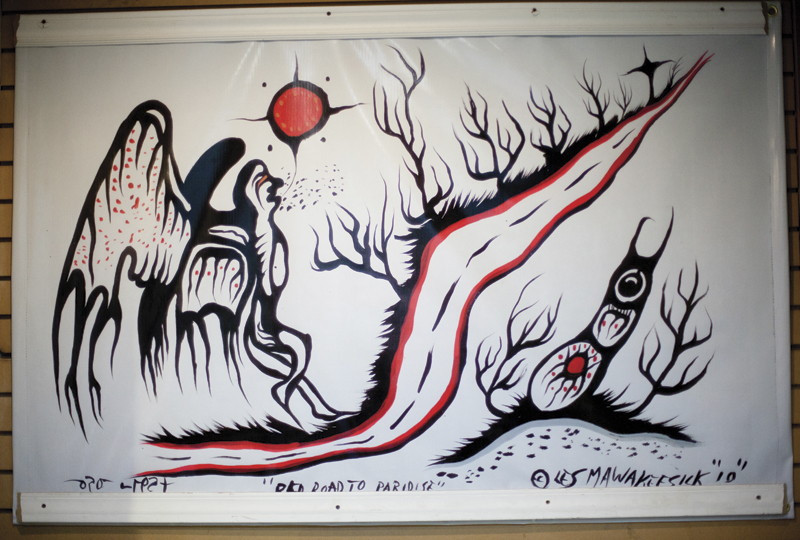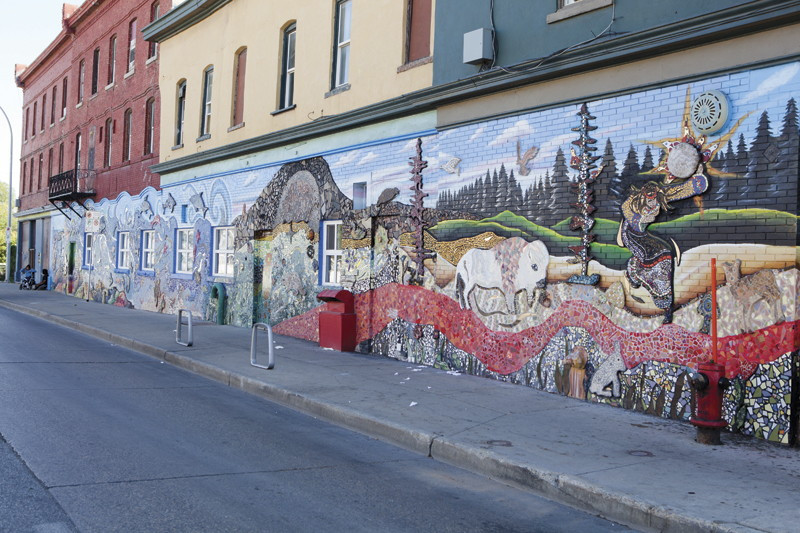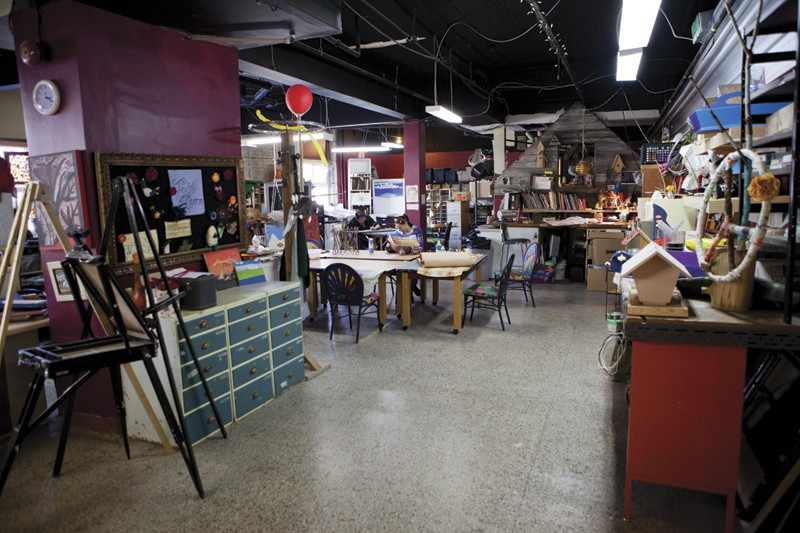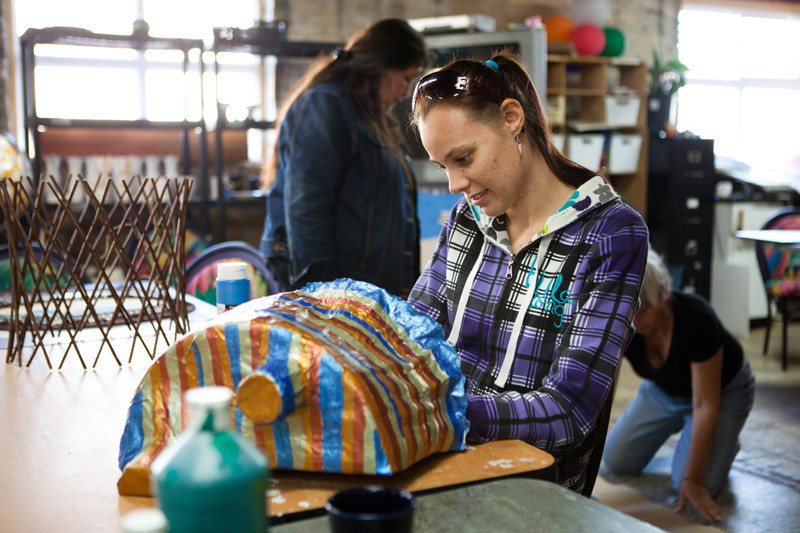Walking the Red Road
Faced with funding cuts, the future of the Red Road Lodge on Main Street is now uncertain
Editor’s note: This story was written before the Red Road Lodge closed its doors this past weekend after losing its funding from the federal government. According to a Metro Winnipeg report, the centre is looking for funding from other sources.
Léo sits across from me, his paintbrush casually swirling reds and yellows as he describes his history with the lodge - the place he’s called home for the past 18 months.
Atop the colour-splattered surface between us are several Pollock-esque abstracts and at least two acrylic depictions of Star Trek’s U.S.S. Enterprise - a broad sampling of his previously completed works.
“I’d always wanted to paint,” he tells me between strokes.
Léo, like so many of the Logan and Main address’s other residents, came upon the Red Road Lodge at a point in his life when, to borrow his words, “there was nowhere else to go.”
As he explains how he came to be a volunteer and then, eventually, a paid employee at the lodge - which offers programming and services for Winnipeg’s homeless - Léo loses his train of thought when a passing resident points out the appearance of “Trekkie art.”
“It’s a bit like living in a house with all of your crazy cousins,” he laughs.
It’s true: the Red Road Lodge is nothing less than a full house.
Sharing the art resource room’s large table with us are a handful of others, busy at work on their own projects.
Cheryl, a young woman who has also come to be employed as a worker by the lodge during her time living here, is adding a layer of paint to her paper-maché creation, while elsewhere a bowl is being decorated and a landscape detailed.
In the neighbouring room, which houses a pool table, a small computer lab, bookshelves and seating, residents and community members alike pass in and out, making use of the free resources.
Perhaps it’s the slightly cluttered, lived-in aesthetic, or maybe the general sense that everyone around here is a part of some quirky, patchwork community where they’re free to come, go and relax - either way, the lodge feels distinctly more like a lodge than it does the sterile bureaucracy one might expect to behold inside of a publicly funded emergency shelter and community resource initiative.
Approachable atmosphere
Earlier in my visit, Beverly Roberts, the lodge’s general manager, told me she wouldn’t have it any other way.
“We don’t look like a service agency provider and we don’t look frightening,” she said. “When people come in and they’ve got their challenges and their needs, we’re so much more approachable.”
Before taking a tour of the former New Occidental Hotel facility and meeting some of its residents, Roberts talked me through the details of something that’s put the Red Road Lodge in the city’s headlines as of late: the threat of a substantial funding cut that would devastate the non-profit project.
She explained that the $112,000 of federal funding through the Homelessness Partnership Strategy (HPS), which the lodge has received annually for the past four-and-a-half years for its life-skills development component and is administered at the city level by the Community Advisor Board (CAB), was revoked after the lodge requested an increase in funding.
“What we needed (an increase in) federal funding for was to support the resource centre that’s open (seven days per week) and also to support the folks upstairs,” she said, motioning to the two stories and their 45 beds above us, some of which house high-needs residents who require specialized attention.
In its most recent proposal, the lodge requested $401,000 in staff on a 16-month term (the previous funding was based on a 12-month cycle) in order to meet these needs.
That was when the unexpected occurred. The entirety of the lodge’s federal funding was pulled out from underneath it suddenly - just like that.
“Gone,” Roberts said, shaking her head. “After four-and-a-half-years.”
She went on to explain that the board’s reasons for rescinding the funds were the lodge’s “large staffing model” and lack of financial viability.
Currently, the lodge can afford 65 worker-hours per week.
Roberts said that, spread out across the full seven days, this means it is essentially impossible to offer full-time hours, which leads to high staff turnover and increased training and hiring costs.
As for the CAB’s second rationale, Roberts thinks misconceptions about just what the lodge is and how it operates are likely to blame.
For one, while the Red Road Lodge is owned by Richard Walls, an Exchange-area developer, it is a completely non-profit entity with no means of bringing in revenue.
The building’s private ownership, Roberts said, might have been misunderstood by the board.
In addition to this, she also suspects the CAB is under the false impression that the lodge’s main floor is just a public art studio rather than a wide-ranging community resource centre that simply incorporates an artistic element, among other opportunities for life-skills development.
Representatives from the CAB could not be reached before press time.
Art’s major role
It’s immediately apparent that art plays a major role in the lodge’s identity.
Later in my visit, Claire Childs, one of the lodge’s workers, led me into the Edge Gallery two doors down, where a number of artists from the local community were setting up their work in preparation for an exhibition taking place later that night.
While a separate entity from the Red Road Lodge, according to Childs, the gallery shares a close relationship with its neighbour, often exhibiting residents’ work.
Inside, I was introduced to Rose, who showed me some of the traditional First Nations clothing she’d crafted and would soon be exhibiting for the first time in more than 30 years as an artist.
I also meet Kevin, whose work consists of detailed, comic book-style pen drawings.
Kevin shared that he was recently diagnosed with cancer. In many ways, he said, the series of works arranged before us as we spoke illustrated his struggle with the disease and a violent past.
While not a resident of the lodge, something about Kevin and his story seemed to affirm the immense positive potential that artistic expression holds for those faced with trying circumstances - perhaps even more so in areas as depressed as Winnipeg’s North Main neighbourhood.
And he’s not the only exemplar.
In the midst of my perusing the gallery, a man in a street worker’s vest entered and introduced himself as Robert.
He’s busy and not much of a talker, he told me, but he heard that there was something being written about the lodge and wanted to help.
We walked down Main Street while he shared his story.
Five years ago, Robert was living on the street, self-described as “a sniffer and an alcoholic” and constantly in and out of various treatment centres.
When he eventually came upon the Red Road Lodge, things finally took a turn for the better.
“Little by little I started to get well,” he said, stressing the process was still by all counts a struggle.
During his time spent living in the building we now walked alongside - where, currently, he is employed as a cleaner - Robert learned how to paint and build birdhouses, among many other things.
Now, he lives on his own.
“This lodge has changed my life. Had I not had that opportunity and that studio, I probably wouldn’t be here today.”
“ The Red Road Lodge - its name an allusion to a concept from pan-aboriginal spirituality in which the “red road” represents the right path in life - stands as an off-ramp both literal and figurative alongside this less-than-red road called Main Street.
Valuable and necessary
However, not everyone who comes through the lodge’s doors ends up like Robert.
Out of the 98 people who lived in the lodge over the course of the past year, there were 42 evictions due to breaches of its rules, which disallow alcohol and illegal drug use.
Still, the occupants of 16 rooms over the same period - individuals, couples and families - transitioned into independent living elsewhere, and have become contributing members of the community.
And that, or so is the impression given by all involved, is more than proof that the lodge is both valuable and necessary in one of the city’s most hard-up areas.
“We can’t afford to lose this place,” said Robert, walking off. “We absolutely can’t afford it.”
It’s a neighbourhood with its struggles, to say the least.
Contrasted against the many other missions and outreaches, pawn shops and squat hotel bars line either side of the wide street, a stone’s throw away.
The Red Road Lodge, its name an allusion to a concept from pan-aboriginal spirituality in which the “red road” represents the right path in life, stands as an off-ramp both literal and figurative alongside this less-than-red road known as Main Street.
Still wearing the sign of its previous tenant, the New Occidental Hotel - a place that, according to an inscription found on an interior wall, was once described by its bouncer of 30 years as the site of “more muggings, knifings, bar brawls and murders” than any haunt in the West - the lodge embodies positive change in more ways than one.
Léo and I continue our conversation: his eyes fixed upon the canvas to which he’s still applying layers of paint.
It’s tough to make out what it is, to be honest. Then again, Léo’s style is generally abstract.
There are curls of yellow amid hazy clouds of grey and flecks of blue and green flung in every direction.
There’s red, too: sweeping, blending bright paths in a storm of everything else.
The more I think about Léo’s piece, the more I realize that, whether he meant to or not, Léo has hit the nail right on its head.
This lodge, like Léo, is putting up red roads where they’re hard to come by. Some of them are meandering and rough around the edges - but red roads none the less.
What’s important now is that this place doesn’t run out of paint.
Published in Volume 67, Number 5 of The Uniter (October 3, 2012)

